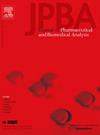Metagenomics combined with untargeted metabolomics to study the mechanism of miRNA-150-5p on SiO2 -induced acute lung injury
IF 3.1
3区 医学
Q2 CHEMISTRY, ANALYTICAL
Journal of pharmaceutical and biomedical analysis
Pub Date : 2024-10-10
DOI:10.1016/j.jpba.2024.116515
引用次数: 0
Abstract
Acute lung injury is a significant global health issue, and its treatment is becoming a hot topic of the researchers. To investigate the feasibility of miRNA-150–5p tail vein injection in the treatment of SiO2-induced acute lung injury through the regulation of gut microbiota and serum metabolites based on multiomics technology. Twenty-four mice were randomly divided into the control, SiO2 and miRNA-150–5p intervention groups. The SiO2 and miRNA-150–5p intervention groups received a single intranasal dose of 100 µL 4 % SiO2 suspension. Meanwhile, the miRNA-150–5p intervention group was administered with two tail vein injections of miRNA-150–5p (15 nmol each per mouse) on the day of successful modelling and on the third day post modelling. Metagenomics and metabolomics techniques were used to measure gut microbiota and serum metabolites, respectively. Tail vein injection of miRNA-150–5p improved SiO2-induced acute lung injury and reduced the secretion of inflammatory factors interleukin (IL)-6, tumour necrosis factor-α and IL-1β. These conditions altered the structure of gut microbiota, which resulted in the notable modulation of eight species at the species level. In addition, tail vein injection of miRNA-150–5p considerably reduced the levels of substances, such as phosphatidylethanolamine, phosphatidylcholine and phosphatidylinositol, in the glycerophospholipid metabolism and glycosylphosphatidylinositol–anchor biosynthesis pathways. Tail vein injection of miRNA-150–5p can alleviate acute lung injury. Combined metagenomics and untargeted metabolomics revealed the miRNA-150–5p-mitigated SiO2-induced acute lung injury that occurred through the regulation of gut microbiota and serum metabolites.
元基因组学结合非靶向代谢组学研究 miRNA-150-5p 对二氧化硫诱导的急性肺损伤的影响机制
急性肺损伤是一个重大的全球性健康问题,其治疗正成为研究人员的热门话题。基于多组学技术,研究miRNA-150-5p尾静脉注射通过调控肠道微生物群和血清代谢物治疗SiO2诱导的急性肺损伤的可行性。24只小鼠被随机分为对照组、SiO2组和miRNA-150-5p干预组。SiO2和miRNA-150-5p干预组接受单次100微升4% SiO2悬浮液的鼻内注射。同时,miRNA-150-5p 干预组在成功建模当天和建模后第三天进行两次尾静脉注射 miRNA-150-5p(每只小鼠 15 nmol)。元基因组学和代谢组学技术分别用于测量肠道微生物群和血清代谢物。尾静脉注射 miRNA-150-5p 可改善二氧化硫诱导的急性肺损伤,并减少炎症因子白细胞介素(IL)-6、肿瘤坏死因子-α 和 IL-1β 的分泌。这些条件改变了肠道微生物群的结构,在物种水平上显著调节了八个物种。此外,尾静脉注射 miRNA-150-5p 还大大降低了甘油磷脂代谢和糖基磷脂酰肌醇锚生物合成途径中磷脂酰乙醇胺、磷脂酰胆碱和磷脂酰肌醇等物质的水平。尾静脉注射 miRNA-150-5p 可减轻急性肺损伤结合元基因组学和非靶向代谢组学发现,miRNA-150-5p通过调控肠道微生物群和血清代谢物减轻了二氧化硫诱导的急性肺损伤。
本文章由计算机程序翻译,如有差异,请以英文原文为准。
求助全文
约1分钟内获得全文
求助全文
来源期刊
CiteScore
6.70
自引率
5.90%
发文量
588
审稿时长
37 days
期刊介绍:
This journal is an international medium directed towards the needs of academic, clinical, government and industrial analysis by publishing original research reports and critical reviews on pharmaceutical and biomedical analysis. It covers the interdisciplinary aspects of analysis in the pharmaceutical, biomedical and clinical sciences, including developments in analytical methodology, instrumentation, computation and interpretation. Submissions on novel applications focusing on drug purity and stability studies, pharmacokinetics, therapeutic monitoring, metabolic profiling; drug-related aspects of analytical biochemistry and forensic toxicology; quality assurance in the pharmaceutical industry are also welcome.
Studies from areas of well established and poorly selective methods, such as UV-VIS spectrophotometry (including derivative and multi-wavelength measurements), basic electroanalytical (potentiometric, polarographic and voltammetric) methods, fluorimetry, flow-injection analysis, etc. are accepted for publication in exceptional cases only, if a unique and substantial advantage over presently known systems is demonstrated. The same applies to the assay of simple drug formulations by any kind of methods and the determination of drugs in biological samples based merely on spiked samples. Drug purity/stability studies should contain information on the structure elucidation of the impurities/degradants.

 求助内容:
求助内容: 应助结果提醒方式:
应助结果提醒方式:


